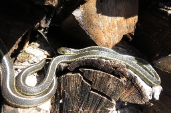Western Terrestrial Garter Snake (Thamnophis elegans)
Description: Most western terrestrial garter snakes have a yellow, light orange, or white dorsal stripe, accompanied by two stripes of the same color, one on each side. Some varieties have red or black spots between the dorsal stripe and the side stripes. It is an immensely variable species, and even the most experienced herpetologists have trouble when it comes to identification. They are medium-sized snakes, usually 18 to 41 inches
Habitat: Thamnophis elegans occurs in a wide variety of habitats, including grasslands, woodlands, and coniferous forests, from sea level up to 12,999 feet. It is primarily terrestrial, although populations in the Great Basin and Rocky Mountains are semi-aquatic.
Range: Thamnophis elegans is found in central British Columbia, central Alberta, and southwestern Manitoba in Canada. It can be found in the western United States, as far east as western Nebraska and the Oklahoma Panhandle. An isolated population occurs in Baja California, Mexico.
Diet: The diet of Thamnophis elegans relies heavily on the prey available in the environment, and thus varies due to geographical differences. This makes the western terrestrial garter snake an excellent example of polyphagism. There are two main variants that are most prevalent: coastal and inland. Since coastal T. elegans is found along the West Coast of the United States, it is found near the coast of the Pacific Ocean. On the other hand, if the snake population is considered to be inland, it is found near inland water sources such as streams, ponds, or lakes.
Coastal populations' food sources mainly include terrestrial prey such as slugs, salamanders, small mammals, and lizards. In contrast, inland populations indulge in a semi-aquatic diet containing frog and toad larvae, leeches, and fish. Thus, aquatic food sources are a staple in the inland snake populations' diet.
Coastal snakes are less likely to respond to chemical cues received from fish, which can be inferred by less rapid tongue-flicking when around them. They are also less likely to attack and ingest fish. This preference in diet is so strong that the snake will starve before eating non-preferred prey types. Further, this appears to be genetically determined as this variation in diet is observed in newborn snakes from both populations. When hunting, the Western Garter Snake's actions are chemically and visually mediated on land and in water. Regardless the habitat in which foraging takes place, both ecotypes utilize similar techniques. This consists of attacks that are both aerial and underwater. These include craning, cruising, and diving. However, coastal snakes are less likely to participate these activities.
These differences in diet and foraging behavior between coastal and inland snake populations suggest that the species has undergone microevolution. Due to dietary and foraging differences between variants of T. elegans, it can be inferred that coastal populations have filled a niche in the environment that allows them to no longer rely on fish as a major food source.
Reproduction: The western terrestrial garter snake does not lay eggs, but instead is ovoviviparous, which is characteristic of natricine snakes. Broods of eight to 12 young are born in August and September.
Status: Listed as Least Concern in view of its wide distribution, tolerance of a broad range of habitats, presumed large population, and because it is unlikely to be declining fast enough to qualify for listing in a more threatened category.
»» Kingdom: Animalia - Animals
»» Phylum: Chordata - Chordates
»» Subphylum: Vertebrata - Vertebrates
»» Class: Reptilia - Reptiles
»» Order: Squamata - Scaled Reptiles
»» Suborder: Serpentes
»» Superfamily: Colubroidea
»» Family: Colubridae - Colubrids
»» Genus: Thamnophis
»» Species: Thamnophis elegans - Western Terrestrial Garter Snake
This article uses material from the Wikipedia article "Western Terrestrial Garter Snake", which is released under the Creative Commons Attribution-Share-Alike License 3.0. Content may have been omitted from the original, but no content has been changed or extended.
|







